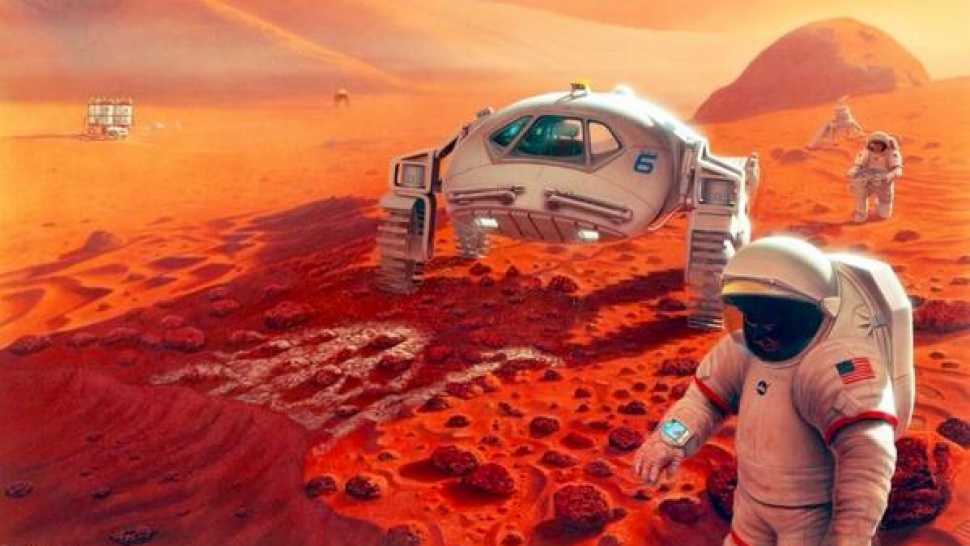Why make human life multi-planetary?
Two reasons:
1) It’s fun and exciting. (Here’s a clip from one of the interviews I did with Elon last year where he articulates this point.)
2) It’s not a great idea to have all of our eggs in one basket. Right now we’re all on Earth, which means that if something terrible happens on Earth—caused by nature or by our own technology—we’re done. That’s like having a precious digital photo album saved only on one not-necessarily-reliable hard drive. If you were in that situation, you’d be smart to back the album up on a second hard drive. That’s the idea here. Elon calls it “life insurance for the species.”
Because Elon thinks that’s a rough estimate for the number of people you’d need to have on Mars in order for the Mars civilization to be “self-sustaining”—with self-sustaining defined by Elon as: “Even if the spaceships from Earth permanently stop coming, the colony doesn’t eventually die out—which requires a huge industrial base, and a much harder industrial base to create than being on Earth.”
In other words, if hard drive #2 relies on hard drive #1 in order to stay working, then your photo album isn’t really backed up, is it? The whole point of hard drive #2 is to save the day if hard drive #1 permanently crashes.
And while the Earth hard drive could “crash” for many exciting reasons—an asteroid hits us, AI kills us, Trump kills us, ISIS creates some upsetting biological weapon, etc.—Elon also warns about the less dramatic possibility that the Earth ships stop coming simply because Earth civilization stops having the capability to send them:
The spaceships from Earth could stop coming for other reasons—it could be WWIII, it could be that Earth becomes a religious state, it could be some gradual decline where Earth civilization just sinks under its own weight. At one point the Egyptians were able to build pyramids, and then they forgot how to do that. And then they forgot how to read hieroglyphics, until the Rosetta Stone. Rome as well—they had indoor plumbing, they had advanced aqueducts, and then that fell apart. China at one point had the world’s biggest fleet of sailing ships and they were sailing as far as Africa, then some crazy emperor came along and decided that was bad and had them all burnt. So you just don’t know what’s gonna happen. The key threshold to pass is the number of people and tons of cargo required to make things self-sustaining. And that’s probably something like a million people and probably something like 10-100 million tons of cargo.

Elon thinks—and I kind of do too—that if the blue circle can get big enough, the yellow circle will take care of itself. If Mars is affordable and safe and you know you’ll be able to come back, a lot of people will want to go.
The hard part is the blue circle. Here’s the issue:
Last time the US Congress checked with NASA, the cost to send a five-person crew to Mars was $50 billion. $10 billion a person. Elon thinks that to make the blue circle sufficiently large, it needs to cost $500,000 a person. 1/20,000 of the current cost.
1/20,000.
That’s like looking at the car industry and saying, “Right now a new Honda costs around $20,000. To make this a viable industry, we need to get the cost of a new car down to $1.”
So what the hell?
Here’s the hell:
Imagine if the way planes worked was that they took off, flew to their destination, but then instead of landing, all the passengers parachuted down to the ground and then the plane landed by smashing into the ocean and blowing up. So every plane flew exactly once, and to have a new flight happen, you’d have to build another plane.
A plane ticket would cost $1.5 million.
- - -
Upcoming Mars Oppositions – and what SpaceX is planning for each
July, 2018: Send a Dragon spacecraft (the Falcon 9’s SUV-size spacecraft) to Mars with cargo
October, 2020: Send multiple Dragons with more cargo
December, 2022: Maiden BFS voyage to Mars. Carrying only cargo. This is the spaceship Elon wants to call Heart of Gold.
January, 2025: First people-carrying BFS voyage to Mars.
Let’s all go back and read that last line again.
January, 2025: First people-carrying BFS voyage to Mars.




Share the News